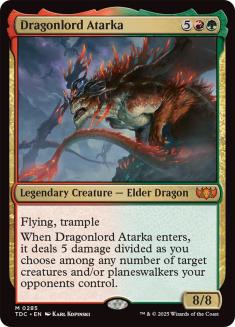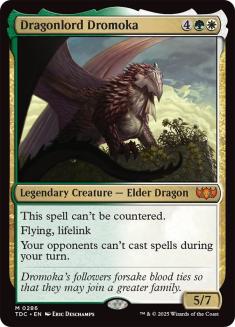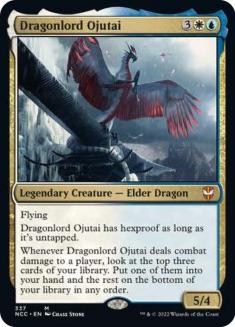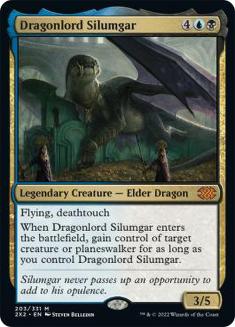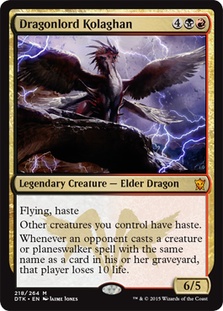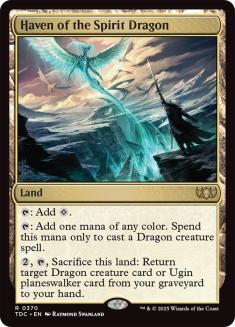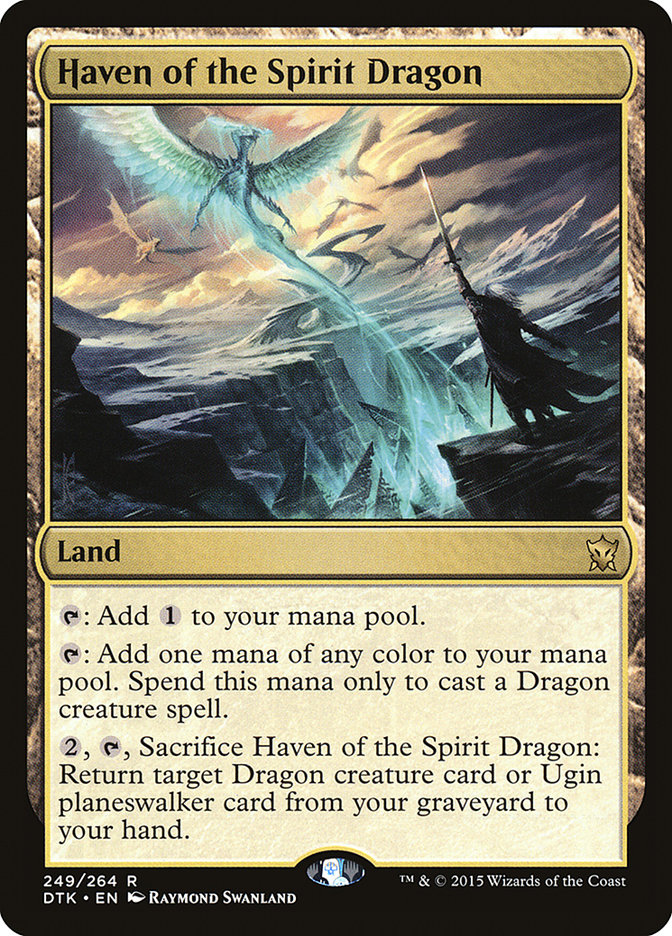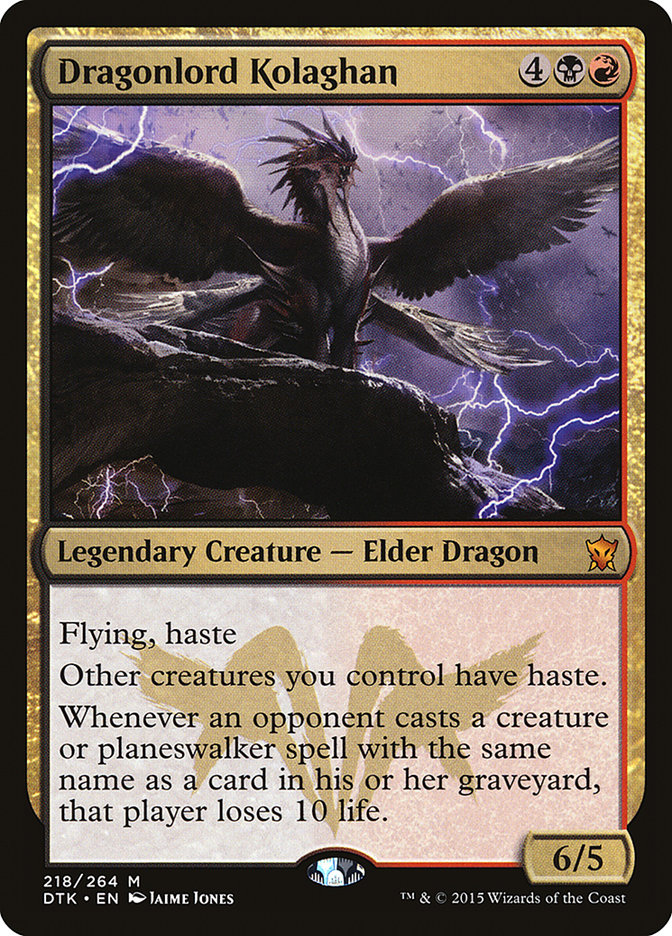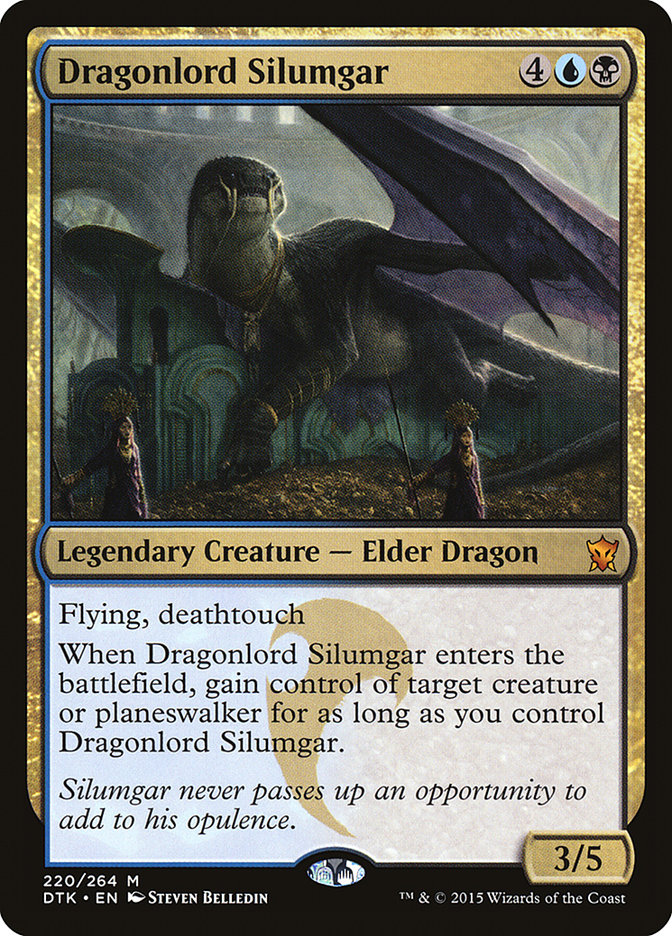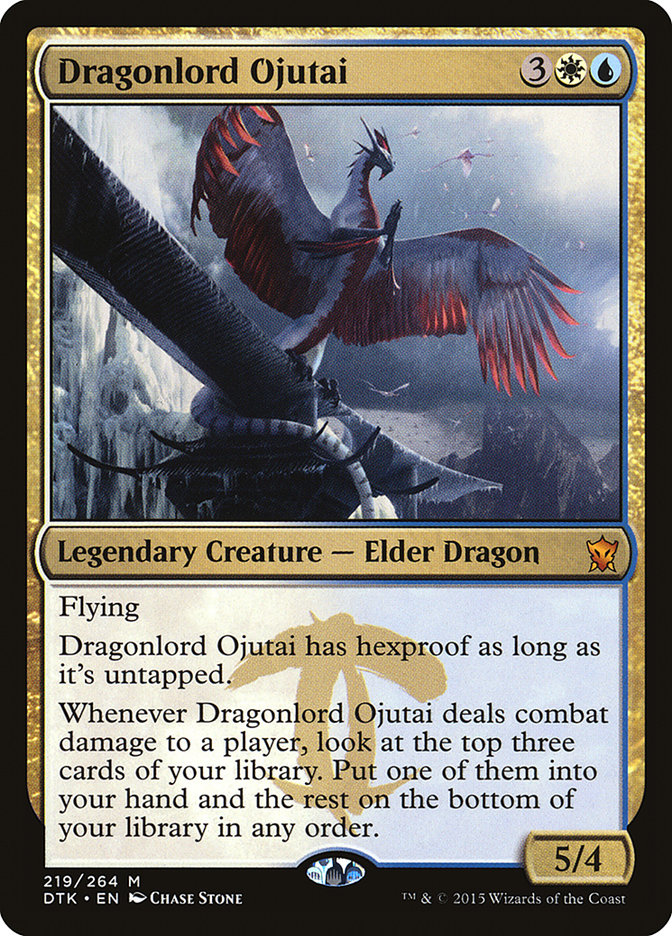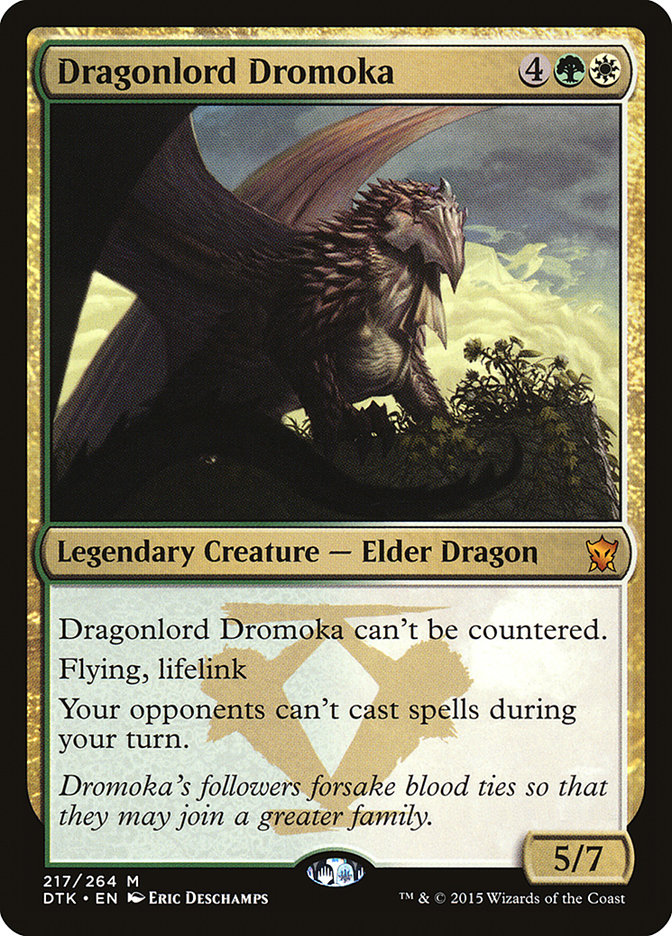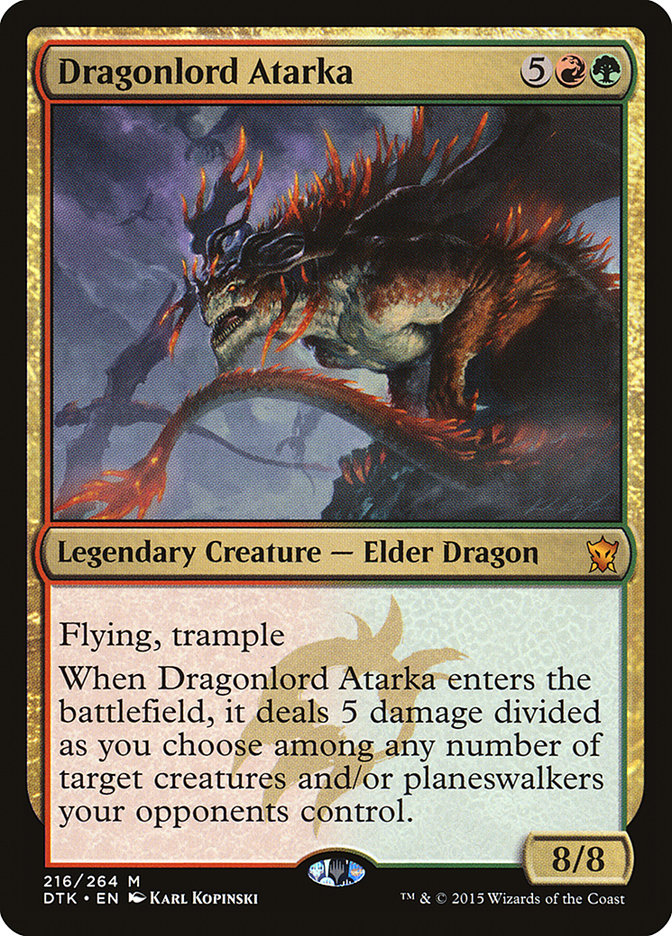Every event is a learning experience. Even with the wins, there is good and bad. While the mix for this event was certainly slanted towards the positive,
there were definitely lessons waiting.
Good
: We realized the format was full of aggressive angles.
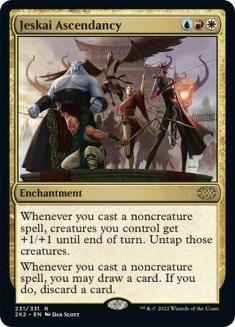
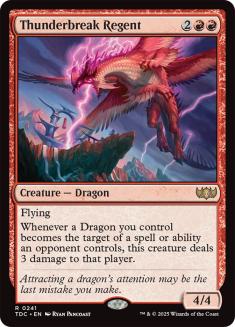
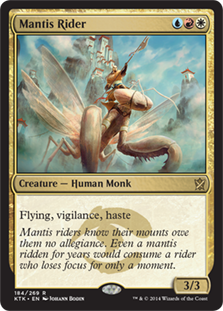
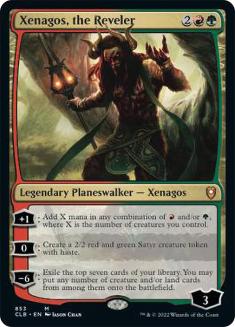
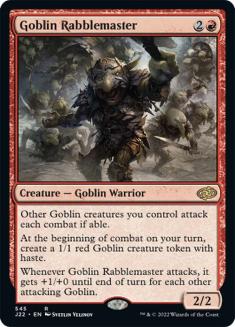
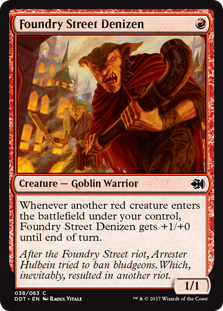
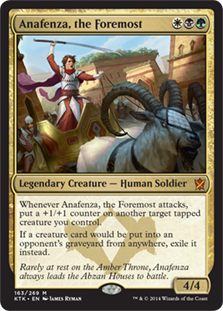

There are a lot of ways to just die fast in Standard. Heck, even one of the “control” decks can play Fleecemane Lion into removal spell into Siege Rhino
and have the game basically over by turn 5.
The best way to combat this is not the removal. While answers got better with Dragons of Tarkir, there are still a lot of mismatches to be had. Hero’s
Downfall versus Hordeling Outburst, Bile Blight versus Siege Rhino, Roast versus Thunderbreak Regent, Ultimate Price versus Fleecemane Lion. You could be
the guy with U/B Control who has tested for months and finds the perfect 75 for the expected metagame, but you could also just be a bit off and lose all
your rounds.
We determined the best answer was to just hit back harder. Every deck we wanted to play was heavy with powerful threats and had just enough answers to
cover the powerful threats that matched up well against the ones it was playing.
Good:
We identified the Dragonlords early on as powerful cards.
We knew very early on that the mythic Dragonlords were going to matter, especially alongside Haven of the Spirit Dragon.
I’m going to start with the last part. Up until now there hadn’t been a real spell-land in Standard. The Temples have allowed you to do work with extra
lands, but for the most part they just let you play five- and six-drops consistently. You are never excited to draw one on turn 12 the way you were excited
to draw Kessig Wolf Run, Vitu-Ghazi, the City Tree, Raging Ravine, or any similar land that actually provided a spell of value. When drawn late, Haven of
the Spirit Dragon is just another copy of your giant threat. Pretty great value for a land. That’s not even counting the fact that it massively upgrades
Satyr Wayfinder into a card that can draw you into action instead of yet another lategame blank.
What about the Dragons you are returning? Stormbreath Dragon is obviously great, but honestly Thunderbreak Regent isn’t really all that. It’s a fine
four-drop if you are in the market for it, but it’s pretty easy to just ignore it. It’s no Siege Rhino or Sidisi, Brood Tyrant that can stabilize a
boardstate, and “just” four damage a turn actually isn’t the greatest clock to race back with.
The real gems are the new Dragonlords, which are all obviously pushed for Constructed purposes. Starting from the bottom up:
Dragonlord Kolaghan is just Rorix Bladewing. Unfortunately, while six haste power is still a real clock, creatures are just better now than they were back
then. Stormbreath Dragon costs one less mana but kills just as fast on curve (five attacks of four damage versus four attacks of six to equal twenty) and
sometimes faster later on with monstrous involved. The one deck we tried this card in was an offshoot of Chris VanMeter’s Starcity Open Syracuse winning deck that splashed black for Ultimate
Price and Murderous Cut for better mirror match removal.
That said, we did have a Kolaghan-color Dragons deck early in testing that didn’t feature the Dragonlord herself. Seth Manfield was shredding creature
decks with something approximating this list.
Creatures (10)
Planeswalkers (1)
Lands (25)
Spells (24)
- 4 Thoughtseize
- 2 Ultimate Price
- 4 Read the Bones
- 4 Hero's Downfall
- 3 Anger of the Gods
- 1 Bile Blight
- 2 Crux of Fate
- 4 Foul-Tongue Invocation
Sideboard

This deck obviously stomped all of the creature decks. It also was shockingly good against U/B Control, as honestly they struggled to actually win the game
before decking if you just saved Thoughtseizes and removal to snag their Pearl Lake Ancient. Note that our U/B Control list did not feature Ashiok, the
Nightmare Weaver, which may change the math there.
The reason we abandoned it was that it couldn’t remove an enchantment. Turns out an in-play Jeskai Ascendancy or Outpost Siege makes playing an attrition
game really hard.
Dragonlord Silumgar also never really found its way into a deck as a keystone but was present in many sideboards. We didn’t put a lot of time into the
Sultai Reanimator shells that tend to be a little fragile to broad aggression (and honestly just Stormbreath Dragon), and the U/B Control decks were
hesitant to include a fragile threat maindeck. Still, it turns out Sower of Temptation is a really good effect, and stealing planeswalkers with your Sower
of Temptation is even better. Once your opponents sideboard down on removal, Dragonlord Silumgar looked really overpowering.
Dragonlord Ojutai first made its appearance in our testing in the Jeskai Tokens deck that Todd Anderson
ended up top 8ing the Season One Invitational with prior to the Pro Tour
. Turns out that shifting into a giant hexproof threat that survives Drown in Sorrow and Bile Blight is a good plan when people are expecting to have to
beat Hordeling Outburst after sideboard. We also worked on Esper Dragons.
Dragonlord Dromoka was a card that went relatively unnoticed at the Pro Tour, but she made a huge impact on our testing. It’s funny to say that it isn’t
flashy when the card is just a Baneslayer Angel. The simple place for it was in the sideboard of G/W Devotion as a huge trump, but the other big home was a
ramp deck with the ability to give the card haste. It can’t be countered, and once it resolves they can’t do anything, so haste is just locking in a
ten-point life swing and an out of position opponent. The deck started off with Dragon Tempest, moved to Temur Ascendancy and Savage Knuckleblade, and
finally settled back into Naya base when we tried Xenagos, God of Revels. Turns out draining ten life is actually more than twice as good as draining five
as the second hit just kills them.
And then there was the Queen herself, Dragonlord Atarka.
I’m not sure if Atarka is actually the most impactful card in Dragons of Tarkir, but she sure is close.
It’s not that over the top threats didn’t exist before. Ugin, the Spirit Dragon. Hornet Queen, Elspeth, Sun’s Champion. It’s not that those cards didn’t
end the game quickly either.
It’s just that Atarka is so good at it, and in the one on one fight is pretty profitable against most of the other big threats.
8/8. Flying. Trample. Kill all of their things. If it dies, you just return it with Haven of the Spirit Dragon. It’s not like they have anything left to
punish you with.
Atarka was so good that half of the team played Abzan Control splashing Red just for the card (obviously designed by Steve Rubin).
Creatures (19)
- 4 Sylvan Caryatid
- 4 Courser of Kruphix
- 3 Satyr Wayfinder
- 4 Siege Rhino
- 1 Tasigur, the Golden Fang
- 1 Sidisi, Undead Vizier
- 2 Dragonlord Atarka
Planeswalkers (3)
Lands (24)
Spells (14)

These cards are seriously good. We almost played this “Dragonlords are basically Titans” ramp deck based on the green ones.
Creatures (29)
- 4 Elvish Mystic
- 4 Sylvan Caryatid
- 2 Xenagos, God of Revels
- 4 Courser of Kruphix
- 4 Satyr Wayfinder
- 3 Whisperwood Elemental
- 4 Dragonlord Atarka
- 4 Dragonlord Dromoka
Planeswalkers (3)
Lands (24)
Spells (4)

Bad
: The new Planeswalkers.
Narset Transcendent I can take or leave. Brian Braun-Duin had an Esper Planeswalkers list that looked promising at first, but too often Narset would miss
once and eat a Hero’s Downfall. There is way too much potential for the card to just do nothing. Domri Rade was good with a similar ability as a way for
aggressive decks to continue to apply pressure. Narset decks are playing from behind, meaning your opponent is always in position to handle a new
Planeswalker if they want to.
Sarkhan Unbroken was the real heartbreaker here. I really wanted this card to be good. It’s Sorin, but it makes 4/4s and draws cards instead of making 2/2s
and gaining life! It’s Broodmate Dragon or a Planeswalker that adds loyalty to draw cards.
The problem is twofold here. First of all, the baseline of 4/4 and two loyalty is a bit fragile. Five loyalty and being up a card is better, but you have
to spend a little more time in Jayemdae Tome before it can impact the board after taking a hit from there. That alone wouldn’t be an issue, but the support
just isn’t there for a Temur deck interested in drawing cards to exist. Their removal just isn’t good enough to make drawing two a turn backbreaking, and
the mana isn’t good enough to pair four colors for spells that don’t have the creature type Dragon to be cast off of your mana-fixing spell land.
Good:
The Abzan Aggro list we ended up playing was very good.
Creatures (21)
- 4 Fleecemane Lion
- 4 Anafenza, the Foremost
- 4 Rakshasa Deathdealer
- 4 Siege Rhino
- 2 Warden of the First Tree
- 3 Surrak, the Hunt Caller
Lands (26)
Spells (13)

Brad Nelson went 9-1 and Austin Bursavich went 8-2 with this exact list.
There are so many good things about the list that Brad and Brian Braun-Duin worked hard to tune.
26 lands: You don’t need a lot of cards to win. They all hit hard. Some of them like Warden of the First Tree and Rakshasa Deathdealer even use extra mana
very well. You just need to cast them on time.
Warden of the First Tree: This card has been growing on me over time. It’s no Figure of Destiny, but the deck definitely wants an additional low-drop with
the addition of Dromoka’s Command. Additionally it still hits hard, adds a bit more lifegain to the deck to offset the eleven lands that cost you life to
use, and becomes a huge lategame trump sometimes. It’s hard to kill G/W Devotion with an active Mastery of the Unseen, but there were a few times in
testing where a 23-power Warden of the First Tree was pretty good at it.
Surrak, the Hunt Caller: This card was just nasty. It’s Blastoderm and Fires of Yavimaya in the same card. If you want cards that hit hard and
fast, look no further.
Dromoka’s Command: There isn’t a universally good two-drop removal spell in this Standard format, but Dromoka’s Command offers blowout potential that all
of the other two-drop removal doesn’t. Counter your removal spell, kill your creature. Kill your Elvish Mystic and your Courser of Kruphix. Win basically
any combat.
Zero maindeck copies of Thoughtseize: Besides U/B Control, this format plays out on the board with many exchanges. Thoughtseize is at an all-time low,
especially with a land in the format that basically counters it. Game 1 you just want to bash them hard and actually gain tempo with your answers.
The sideboard Elspeth, Sun’s Champion and Wingmate Roc: It wouldn’t be a Brad Nelson deck without the old sideboard juke, would it? Sometimes there are
matchups that can play at parity with you and have finishers for the end game, namely Abzan Control and the mirror. You want trumps to match there. It also
helps that these are live cards to sideboard out removal for against control.
Moving forward, I would definitely play this deck again with at most some small adjustments.
Bad:
I had no idea how to play this deck.
My lack of experience with the current Standard format came back to bite me here.
There is not a lot of margin with this deck. While your cards are powerful, you don’t have a big window before they can will be outclassed against some
decks. I was way too loose with my mulligans and got punished once or twice by it when I kept hands that looked good but really just didn’t do enough early
on.
Rakshasa Deathdealer, Warden of the First Tree, and Fleecemane Lion lead to a lot of hard decisions about spending your mana. Do you play fast and loose,
or do you play conservatively? I punted a game where I opted to leave up mana for Deathdealer’s regenerate, but I should have obviously pumped. My opponent
had no removal spell in hand and the lack of pump let him Dig Through Time before the Deathdealer would kill him. He found a way out of the situation at
one life in his seven cards and easily regained control.
I used to be really good at these established format events, but I have just spent a lot less time actually playing Magic these days. I need to treat these
non-rotation Standard events the same as a Modern Pro Tour and just start testing the day the previous one ends in order to have a good base for whatever
wrench gets thrown into the format.
Bad:
We underestimated U/B decks
I’m not really sure what happened here, but I have a theory.
The U/B decks underperformed early in our testing, as they were short on win conditions or stumbled on lands. Our stock list had four ways to win, and it was often easy for it to
just run out of them. The three color list with Dragonlord Ojutai was a little better, but the mana was not good. You could easily miss a step due to a
tapped land or missing a color and just die. There were also a few specific problems it fell prey to without Perilous Vault. The deck also got
significantly worse after sideboard as it just shifted answers, while other decks actually turned dead cards into live ones.
As a result, we cut back on our U/B testing. And so did everyone else when they realized G/R Dragons was a big threat.
U/B then showed up to a Pro Tour of people who actively didn’t prepare for it and crushed. The whole “it loses sideboarded games on top of clunking out
sometimes” issue was cut in half, and it was actively the best deck in the format for the metagame.
The deck is easily answerable moving forward as long as you have a dedicated plan, but this weekend we just got a hard and fast reminder of why you have to
respect it.
Good:
Our Limited testing process worked as planned.
Here’s the condensed version of what we found:
Dragons of Tarkir Draft is fast. If you fall behind early, you die. You need 4-6 two-drops to not just get run over.
Once that happens though, everything trades. The two-for-ones and card draw that traditionally break these trading situations profitable are hard to cast
in an aggressive format, so the breakers are the cards that don’t trade or trade up. When you look, these are just good removal spells and overly efficient
creatures, or basically the traditional Limited pillars.
As a result, being able to get more of these good cards is huge. Drafting is all about positioning yourself in the draft for the best reward. Reading and
sending signals is key.
Ditch your first pick rare if you don’t see the cards coming for the color. Find the open color fast and cut them hard to reap the rewards later. If given
an even choice of cards when one is the only one of a color and the other has multiple playables on color in the pack, pick the one that is less likely to
put people downwind of you into the color.
Bad:
I was burned out for Day Two and played horribly.
While I navigated the first draft very well, I made some loose picks early in the second draft. I salvaged it reasonably well with what was solid deck that
went 1-2 due to some poor breaks, but the deck that could have been was significantly better. When I got to the second Constructed portion it had only
gotten worse.
If anyone has good tips for beating US to Europe jet lag, let me know.
Bad:
There are a tilting amount of french fries here.
French fries are a sometimes food. Except in Belgium.
I ate one meal that didn’t come with French Fries. It was Indian food.
I’m fairly sure I’ve consumed more fries in a week here than I did in the past year in Boston.
Please. Stop. No. More. Potatoes.
Good:
The Team.
There was a big shift between Pro Tour Fate Reforged and Pro Tour Dragons of Tarkir for my team. Only five of our members were requalified (me, Seth
Manfield, Brad Nelson, Steve Rubin, Craig Wescoe), and Craig opted to work with Team Ultra Pro for this event as their deck preferences tended to align
closer to their members than ours. He builds finely tuned decks that do his thing so he can play optimally, and we tend to cast a broader net to catch the
decks that are technically the best. Given our finishes and his 12th place, the breakup was clearly amicable both from a personal and results stand point.
With a string of three Standard Pro Tours coming up, Chris Fennell wasted no time in talking to the best Standard players around, and we acquired Brad
Nelson and Brian Braun-Duin. From there we filled out the same way as always: qualified friends who are also great at the game. Michael Majors, Austin
Bursavich, Mark Nestico, and Ray Tautic were the first four, and Gabe Carleton-Barnes made a surprise appearance after spiking the second to last online
PTQ for the event.
There were some growing pains, as there always are with a fundamentally new group, but overall it was good. While we missed top 8 by a match, we put four
of eleven people into the 11-5 or better bracket, which is where requalifications and large pro point gains happen. Despite my 7-7 finish straight out of last Pro season, I’m still in range of Player
of the Year and American Team Captain, Brad is now locked for Platinum, Steve Rubin is only two points away from being locked for Platinum after finishing
11-5 at a third consecutive Pro Tour, Seth is well in range of the World Championship despite missing top 8, and Austin just qualified for at least the
next two Pro Tours.
Overall, everything is good. If we keep troubleshooting the things we notice as issues moving forward, it will only get better.

